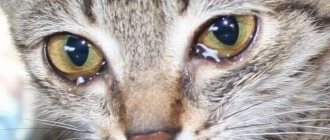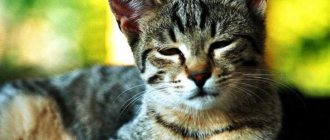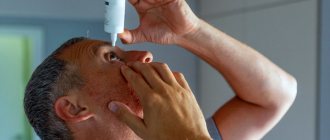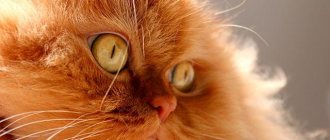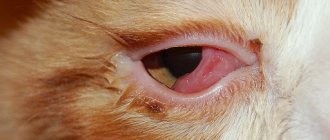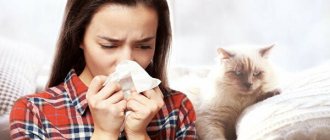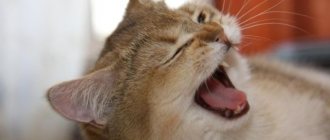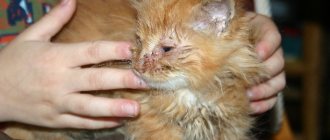If your Scottish kitten has watery eyes, it could be due to many factors. In addition to the physiological characteristics of these pets, which involves discharge from the visual organs, the problem is sometimes observed with the development of pathological conditions. That is why it is important for owners of Scottish cats to monitor their animals’ eyes and, if they are leaking heavily, contact a veterinary clinic.
How to care for the eyes of a Scottish cat?
The eyes of Scottish cats require regular care - from once a week to 2-3 times a day, depending on their condition.
If everything is fine with the cat and there is no discharge or it is within normal limits, then nothing needs to be done. If your eyes water after sleep or crusts accumulate in the corners, you can wipe them as they appear. But if the discharge is cause for concern (for example, it is green or there is a lot of it), then you need to get tested by a veterinarian and act as prescribed. When treating a number of diseases, eye care occurs 2-3 times a day. How to wipe the eyes of a Scottish kitten or an adult cat? For preventive purposes, wipe or wash with cooled, barely warm, decoction of chamomile, green tea, St. John's wort, calendula or special drops
When choosing drops, make sure that they do not contain antibiotics.
Tetracycline or ofloxacin ointment, as well as chloramphenicol drops are used for infectious diseases. However, you should not use them if your cat’s eyes are watering for an unknown reason and it is not a fact that it is an infection. The fact is that tetracycline and chloramphenicol are antibiotics and their use without indications is undesirable.
Similar wishes can be expressed regarding “Diamond Eyes” drops and the like, which are actively recommended by many cat breeders. These drops contain a bactericidal drug - chlorhexidine digluconate, which suppresses bacterial flora (gram-positive and gram-negative bacteria), darmatophytes and lipophilic viruses. Now imagine that your cat does not have a bacterial infection, but, for example, an allergy, for which it is undesirable to use chlorhexidine bigluconate. These drops should be used only for infections, and not for any infection.
The main advice is to use critical thinking when choosing medications and when identifying the causes of illness, consult with a veterinarian you trust. If there is no one you trust, double-check the diagnosis with two doctors.
How is the treatment carried out?
A veterinarian will help determine the causes of lacrimation and prescribe treatment according to the identified ailment.
If your fold-eared cat has watery eyes, the animal should be taken to a veterinary clinic. The doctor will conduct the required examinations that will identify the factors that contributed to the development of this condition. If the cause of the problem is inflammation of the mucous membrane, you will need to wipe and rinse the British woman’s eyes with an antiseptic medication. A solution of Furacilin is often prescribed.
The procedure is carried out three times a day.
Veterinarians also prescribe eye drops for the Scottish kitten. You can use Sofradex, Kanamycin and Tsipromed. When British and Scottish people have watery eyes due to allergic reactions, the only treatment is to find the allergen and eliminate contact with it. Sometimes they resort to corticosteroids, but these medications have many side effects, so they are prescribed only in advanced situations.
Return to contents
Scottish Fold cat has watery eyes
Our Scottish Fold kitten's eyes are constantly watering. Tell me, is this a feature of the breed or is it still a disease?
Don't be alarmed - Scottish Fold kittens often have watery eyes. This is caused by the special shape of the cat's skull, shortened tear trough and narrowed tear ducts. A slight discharge of clear fluid from the eyes, especially after sleep, is considered normal. Tearfulness will continue to appear after the kitten grows up, but not as pronounced.
If your kitty's eyes are constantly wet and puffy, I would suggest taking him to the vet. You should be especially wary when the kitten does not fully open its eyes and constantly rubs them. The cause of tearfulness can be not only a breed defect, but also diseases. If you miss the vaccination dates, the kitten may develop a disease, one of the symptoms of which is lacrimation. In addition, a kitten's eyes often water from being exposed to fluorescent lighting all day.
Agree with you! An examination by a veterinarian will not be superfluous. Your kitten's eyes may be watering because the tear ducts are blocked. Causes of lacrimation can be allergies, increased eye pressure, cataracts, entropion of the eyelid, inflammation of the cornea (keratitis), colds, or mechanical damage to the eyeball. Watery eyes are caused by worms and other parasites, as well as viral, infectious and fungal diseases. Only a veterinarian can determine the exact cause and prescribe proper treatment.
There may be several reasons why Scottish Folds have watery eyes. It should be noted that the fold-eared cat has a shortened tear trough, so Scottish Folds always produce a little more tears than cats of other breeds. But let's not talk about the characteristics of the breed.
First, your cat may suffer from allergies. This is not something that is usually thought of when one notices increased discharge from a cat's eyes. Meanwhile, this happens quite often. Additional symptoms indicate an allergy: peeling of the eyelids and skin, redness, nausea and vomiting. Change your cat's diet and you will get positive results.
Secondly, excessive tearfulness can be caused by viral or fungal diseases.
Thirdly, this happens due to an inversion of the eyelid. True, this is noticeable from the outside. The cat constantly rubs its eyes, trying to get rid of the bloat that bothers it, so you can quickly recognize such a problem.
Fourthly, tearfulness appears due to inflammation of the cornea or keratitis. Eye diseases occur in cats, but they go away quite quickly.
I'll add. Scottish Folds have watery eyes due to clouding of the lens or cataracts. Such diseases are common in older cats. Cataracts render Scottish Folds over ten years of age half or almost completely blind. The lens becomes cloudy and white. And, alas, there is no cure for this. Tearfulness may occur due to increased eye pressure. This problem is also common in older cats and can be treated with medications for high intraocular pressure. Increased tear production may be caused by missing the vaccination period. This happens when a cat develops some kind of disease, but there is no immunity to the disease. How to avoid such trouble? Don't miss vaccination periods!
It could also be a simple blockage of the tear ducts. This happens in fold-eared cats. How to treat? Wipe with a cotton swab to get rid of clots of dried tears. In addition, lacrimation appears from a common cold, mechanical damage to the eyeball or worms. Get rid of the root cause and your cat will be healthy again.
https://koshkamurka.ru/872-u-shotlandskogo-kotenka-slezyatsya-glaza.htmlhttps://vk.com/topic-49418358_31108104https://lapkins.ru/f/u-shotlandskoy-visloukhoy-koshki-slezyatsya- glaza-204/
Morning tears
The normal scenario for the formation of discharge is that a kitten’s eye runs in the morning or, especially at a young age, after a nap. During rest, all vital processes enter a passive phase, tear production slows down, the fluid becomes more viscous, and clots may even form.
Awakening activates the withdrawal of these substances, which cleanse the body of unnecessary elements.
If your kitten's eyes are watery in the morning, you can give him a small rinse with a hygienic solution at home. At the same time, the crusts in the corners of the eyes are carefully removed and the pathways for new tears that are clogged by them are opened.
Purulent discharge from a Scottish cat
A separate column is worth addressing such a topic as the release of purulent deposits. The most common cause of pus in a Scot is conjunctivitis.
If a Scotsman's discharge is watery and its color is transparent, then this indicates that the eyes are watery. In most cases, this is a mild form of allergy.
shutterstock
However, if the discharge has a thick consistency, leaves “dark circles” around the eyes, or has a yellow, green or brown tint, then this is a reason to visit the veterinarian as soon as possible. Most likely, this is purulent conjunctivitis.
There are three types of conjunctivitis:
- Viral. With this type of conjunctivitis, your Scottish kitten will usually have watery eyes. In addition, the eyelids show signs of irritation, redness and itching.
- Bacterial. This type of conjunctivitis also causes watery eyes. The eyelids stick together due to copious discharge of pus. Eyes red and irritated. The lesion occurs alternately (i.e., first one eye, then the second).
- Allergic. The eyes become watery, swollen, and very itchy.
If conjunctivitis is considered by severity, then three degrees can be distinguished:
- Serous. This is the mildest form of conjunctivitis. With her, for the most part, the eyes just water. The eye socket itself has a pink, healthy tint. Minor swelling may be present. Basically, this form occurs with allergies or with increased sensitivity of the eyelid to external irritants (for example, wind or cold).
- Purulent. With this form, pus is released in large quantities, the eyelid is red and swells quite a lot. The cat is itchy and scratches constantly. Along with the pus, you may also notice that your eyes are watering.
- Follicular. This type of conjunctivitis is characterized by the appearance of neoplasms in the form of blistered and rough tissue in the third eyelid. Constant friction causes irritation, redness, and watery eyes. This type of disease can be corrected exclusively with surgery or medication.
Pathology or not
If a cat’s eyes are running, this phenomenon may be normal or indicate a pathological process.
In case of various diseases in a pet, the discharge is characterized by an unusual color (yellow, transparent, red, brown, green). In pathology, tears flow heavily, the eyes are slightly swollen, and the animal constantly rubs them. Sometimes the cat cannot open them completely.
The British man's eyes are watering - is it pathological or not? This question can be answered only after assessing the condition of the animal, the nature of the discharge and other factors.
Discharge rate
In cats of this breed, discharge is considered normal if:
they are transparent;- not very abundant;
- occur after sleep.
In this case, there is no need to treat the animal. This is a normal process in British breed cats.
Kitten care
Caring for Scottish Fold kittens is easy. The coat does not require special care; it is enough to comb it once a week; it is enough to wash the eyes once every 5-7 days.
The only thing worth paying attention to is ear care. This issue should be treated with the utmost care.
It is the ears that are the calling card of this cat breed, but at the same time they are also a weak point.
Eye examination and cleaning
If your eyes are healthy, then there is no special need for rinsing, you just need to keep them clean. But if the eyes are inflamed, they should be washed 2-3 times a day; this can be done with plain water, a weak chamomile solution or a medicated solution. To do this, you should use a cotton swab or soft cloth. If the inflammation lasts more than a week, then you need to consult a specialist.
Ear cleaning
This procedure should be done two to three (more often) times a month. To clean, use a cotton swab slightly moistened with a special liquid. The procedure must be carried out carefully so as not to damage the auricle.
This is interesting! It is better not to use cotton swabs, but regular cotton swabs will do just fine. You should not twist or pull the ears, as this can cause pain to the kitten and he will be afraid of this procedure. If the ears are healthy, there is no discharge, but there may be a small amount of earwax.
The presence of a thin brown crust in the ears is an alarming sign; it indicates the presence of ear mites. In this case, you cannot do without a visit to the veterinarian. The treatment will be long with the help of a special solution. If measures are taken in time, the prognosis is favorable.
Grooming
To keep your Scottish Fold kitten beautiful and well-groomed, you need to take care of its fur; it’s not at all difficult. To properly care for the coat, you should use a special brush or silicone glove. During the shedding period, it is recommended to comb it once a week, the rest of the time once every two weeks will be enough.
While at the dacha, you should pay special attention to this procedure, carefully examine the animal every day for ticks and other parasites.
Bathing, washing
Scottish fold kittens must be accustomed to water procedures from childhood. To do this, you need to gradually moisten them with a damp towel, and then give your pet a treat so that he develops a reflex that a bath is not scary. In the future, you can safely wash the kitten. Particularly active kittens are recommended to be protected in a special way before taking a bath. To do this, cover your ears with tampons. or you can simply cover them with your hands to prevent water from entering. Your eyes also need protection; you can even drip special protective oil into them, but this is not necessary.
Important! The water should be warm, approximately 36 degrees. Water that is too cold will cause hypothermia and your Scottish Fold kitten will get sick.
Hot water is also harmful; due to the increased temperature, the animal’s heart rate will increase and breathing will become more difficult. Eventually, your pet will not tolerate the uncomfortable conditions and will escape from the bathroom.
When washing your Scottish Fold kitten, be sure to use cat shampoo, and then its coat will be healthy and shiny. The products are not suitable for humans, they will cause skin irritation and worsen the condition of the coat; in severe cases, dermatitis is possible.
Nail trimming
Very sharp, thin claws of a kitten should be trimmed with special clippers for small animals.
The advantage of such a tool is that they give a straight cut without splitting the claw - this is very important! When caring for a kitten's claws, only the very tip is removed. Under no circumstances should you damage a blood vessel, this will cause severe pain and can lead to the most negative consequences.
In this case, a simple rule applies: it is better to cut off too little than too much.
Discharge from a cat's eyes - where is the norm?
A small amount of discharge after sleep is considered a physiological norm. But if the eyes are constantly wet, discharge of a strange color, the eyes are swollen, the conjunctiva is inflamed, the cat cannot fully open the eyes and rubs them, you need to contact a veterinarian, because... This is no longer the norm. You should also be wary if there are too many tears and they flow constantly. This phenomenon is called epiphora in veterinary medicine.
Article continues after advertisement
The color of the discharge also plays a role. Transparent watery discharge most likely indicates an allergy, mechanical irritation, or problems with the nasolacrimal duct. Green and yellow purulent discharge is a sign of infection. Red discharge can indicate the presence of worms, but more often red-brown crusts are not a sign of worms, but simply tears that have oxidized due to oxygen.
Therapy methods
Treatment primarily depends on the underlying cause of your cat's watery eyes. If the phenomenon is provoked by a physiological factor and a peculiarity of the breed, then the pet’s eyes should not be treated.
At home, when the disease develops, the following remedies are used to treat the eyes:
- tetracycline ointment;
- Levomycetin drops;
- Furacilin;
- Sulfacyl sodium;
- Albucid;
- solution of potassium permanganate (weak).
The veterinary pharmacy sells special medications.
The following drugs are considered effective:
- Diamond eyes;
- Phytoelite;
- Iris.
If medications used for 2-3 days are ineffective, the cat must be shown to a specialist.
In addition to eye treatment, treatment should be aimed at eliminating the underlying cause that caused this symptom.
If the pathology is caused by worms, anthelmintic drugs are used. Antibacterial agents are used for various infections. Watery eyes caused by allergies are treated with antiallergic medications.
Traditional methods of treatment
What to do if you don’t have any medications on hand, and your cat’s eyes are watering? In this case, traditional therapy recipes are used. These include decoctions of medicinal plants.
Herbs used are:
- chamomile;
- marigold;
- calendula;
- green tea;
- sage;
- St. John's wort.
They help eliminate crusts containing pus after the cat wakes up, relieve the inflammatory process, and inhibit the growth and reproduction of pathogens.
Main reasons
Experts identify many factors that cause lacrimation in a pet.
Most often, pathology occurs due to the following reasons:
entry of a foreign body into an organ;- helminthic infestations;
- structural features of the head;
- allergic reaction to certain products;
- improper care of your pet;
- infectious diseases;
- eye injury.
If these reasons provoke lacrimation in a cat, then drug treatment is used.
Physiological reasons
If a symptom has developed as a result of physiological factors, eye treatment does not need to be performed.
These reasons include:
breed characteristics;- discharge from the eyes after eating;
- after waking up.
Light from fluorescent lamps is also considered a physiological reason for the development of this phenomenon: bright lighting irritates the eyes, and discharge begins to flow from them.
Disease provocateurs
Watery eyes are often caused by various diseases. The following infections can provoke a pathological phenomenon:
- chlamydia;
- herpes;
- rhinotracheitis of viral etiology.
Your cat may have other problems caused by pathogens.
Their symptom may also be bleeding from the eyes. A pathological phenomenon sometimes indicates conjunctivitis, the causative agents of which are viruses or bacteria .
Tears may be a sign of respiratory disease. In this case, the Scot will suffer from other symptoms, for example, hyperthermia, cough, runny nose, and his general condition worsens.
Infections
Viruses and bacteria often cause excessive tearing. Some of them are difficult to treat (for example, panleukopenia). Some diseases are transmitted to people (mycoplasmosis, chlamydia, herpes, etc.).
Diagnosis is required to determine the disease. According to veterinarian statistics, chronic conjunctivitis (long-term inflammation of the eye mucosa) is most often detected. Such animals require a thorough ophthalmological examination with the Schirmer test (to confirm or exclude creatitis), determination of eye pressure (possible glaucoma), etc. The appendages of the eyes must be examined for eyelid abnormalities.
In case of mucopurulent discharge, a test for the sensitivity of the microflora to antibiotics will most likely be required. The analysis is done before washing the eyes or using any medicinal substances (drops, ointments), which will certainly distort the results by reducing the concentration of bacteria or slowing down their reproduction. Cytological examination is necessary to diagnose eosinophilic or allergic conjunctivitis. Infection is indicated by altered neutrophils (a consequence of the work of bacterial cells). Sometimes viral bodies (intracellular inclusions) and chlamydia are detected.
An infection can be ruled out by washing the conjunctiva for rhinotracheitis, mycoplasmosis, and chlamydia. If the tests come back negative, you should consider an ophthalmological examination.
How to distinguish an allergic runny nose from a cold
The doctor makes a diagnosis based on medical history, complaints, results of a clinical blood test and examination of the mucous membrane (instrumental or endoscopic rhinoscopy). In allergic rhinitis, the epithelium of the nasal passages is pale, loose, the mucous membrane of the oropharynx is not inflamed, and the level of eosinophils in the blood is increased. To confirm a suspected allergy, an enzyme-linked immunosorbent blood test for immunoglobulins E is prescribed, as well as skin prick allergy tests3.
To distinguish an allergic runny nose from a cold on your own, analyze the symptoms:
- With allergies, rhinorrhea and sneezing increase sharply when inhaling air filled with allergens. They irritate the ciliated epithelium of the nasal mucosa. For example, hay fever manifests itself more intensely outdoors in hot, dry weather. With viral rhinitis, external factors do not affect the amount of secretion from the nasal cavity.
- Allergic rhinitis develops acutely and is not accompanied by hyperthermia. Cold symptoms increase gradually, body temperature can reach 38-39℃.
- Discharge from the nasal passages with a cold changes in color and texture, while with allergies it remains watery.
- Itchy skin, watery eyes and red eyes are characteristic signs of allergies, and they are rare with colds.
- Symptoms of a viral infection disappear under the influence of antiviral drugs and vitamins. For allergies, this treatment does not produce results.
- Sensitivity to irritants is dulled after taking antihistamines. Antiallergic medications do not work on colds.
Also, allergic status is often inherited. You can suspect an allergy if there are asthmatics and allergy sufferers in the family.
Diagnosis of a cat with lacrimation
To correctly diagnose a possible disease, you should observe the cat. Sometimes eye problems are accompanied by behavioral changes. Decreased activity and refusal to eat may confirm the presence of the disease. During a visual inspection it is necessary to determine:
- both eyes or only one are affected;
- how often does tearing occur?
- how much tears are produced;
- what is the purity and color of the eyeball;
- whether there are traces of blood or pus in the liquid;
- whether the mucous membranes and eyelids swell;
- Is there a prolapse of the third eyelid?
To find out the reason why your animal's lacrimation occurs, you should carefully examine the organ of vision. Before doing this, first wash your hands or wipe them with a disinfectant solution. The cat's eyes are washed to remove secretions and examined by gently pulling back the lower eyelid. Based on the diagnostic results, a clinical picture is drawn up. Signs of eye problems are determined by the condition of the visual organ and the nature of the discharge.
If a cat sneezes and tears flow
The cause of excessive tearing may be due to a bacterial, fungal or viral infection. At the same time, the cat sometimes coughs, sneezes and watery eyes. With such a problem, diseases of the respiratory system cannot be ruled out. The animal is tested for mycoplasmosis and chlamydia. With a weakened immune system, the disease can last more than a week. Another reason why a cat has watery eyes, coughing and sneezing is an allergy.
If the tears have a brown discharge
The brown color of tear fluid is due to the presence of dark-colored pigments in it. There are several reasons for this lacrimation. Some cats have brown tears because they have a short, narrow tear duct. A growing tumor can lead to a narrowing of the canal. But the anatomical structure of the organ is not always the culprit. In some cases, dark liquid accumulates due to infection of the body with worms or non-infectious inflammation of the lacrimal sac. Another reason is trauma, due to which blood enters the tear secretion.
Tears and purulent discharge
If the eyes water and pus is released, then bacterial conjunctivitis, blepharitis or keratitis is diagnosed. Sometimes the disease is aggravated by a viral infection, chlamydia. If the cat suffers from allergies, the inflammatory process is aggravated. The discharge may have a yellow, greenish, or light brown tint.
Red eyes and watery eyes
The cause of reddening of the whites with excessive tearing may be an organ injury or a foreign body getting under the eyelid. If both facts are not established during the examination, the option of allergies or increased intraocular pressure is considered. With these problems, the blood vessels often dilate and the eyes water. The cat blinks frequently, squints and avoids light.
The cat has one eye that is watery and swollen
If the problem affects only one eye, the most likely cause is mechanical damage to the organ. This could be an injury due to a blow or a sharp object getting under the eyelid. Also, the cat's eye waters and swells with unilateral conjunctivitis or glaucoma. The last problem is accompanied by a painful effect and disorientation of the pet in space. When diagnosing unilateral lacrimation and edema, it is necessary to exclude a tumor.
Tearing and cloudy eyes
If your cat's eyes are watery and cloudy, the cornea and lens need to be examined. If the color of the clouding is whitish or light blue, and the spot itself is matte, then the pathology is most likely associated with the cornea. If in the light, along with a decrease in the size of the pupil, the cloudy spot decreases, then the problem is related to the lens. Potential causes of turbidity and lacrimation are also infections, organic inclusions, scars, and vascular proliferation.
When to see a veterinarian
It can be difficult to determine the cause of lacrimation without the help of a veterinarian. The situation is aggravated if the eyes not only water, but also become inflamed. If there is any doubt, a specialist examination is necessary.
An indication for a visit to the clinic may be if:
- lacrimation continues for more than a day;
- a foreign object was found on the mucous membrane;
- there is pus or blood in the discharge;
- eyelids and mucous membranes are swollen and red;
- noticeable obvious clouding of the cornea;
- prolapse of the third eyelid was detected;
- the cat squints or does not open its eyes;
- nasal discharge appeared;
- The animal has a fever.
Even if the listed symptoms do not overlap, and only one of them is noted, you should not postpone a veterinary examination. When a cat's eyes are watery, help should be immediate. The pet’s vision and overall well-being depend on the owner’s timely reaction.
Watery eyes as a sign of disease
Watery eyes can be a symptom of both an eye disease and a general illness.
Watery eyes as a symptom of eye pathology occurs when:
- injury to the eye and eyelids - there is a narrowing of the palpebral fissure of the injured eye, redness of its mucous membranes, the appearance of discharge of a different nature: from bloody-mucous in case of a fresh injury to purulent if the eye has been injured for a long time. A cat with an eye injury should be taken to a doctor to diagnose the type of injury and prescribe appropriate therapy;
- inflammatory diseases of the eye and its adnexa, can be unilateral or bilateral in nature: conjunctivitis - inflammation of the conjunctiva. Manifests itself in: redness and swelling of the conjunctiva;
- photophobia;
- the third eyelid may fall out;
- possible narrowing of the palpebral fissure;
- the presence of mucous or mucopurulent discharge.
- redness and swelling of the eyelids;
- redness and swelling of the eyelids;
- severe pain syndrome;
- the presence of swelling on top in the area of the outer corner of the eye, painful on palpation;
What symptoms require urgent contact with a veterinarian?
You should consult a doctor if:
- persistent lacrimation - more than a day;
- a sharp foreign object is visible in the eye;
- redness and swelling of the eyelids;
- purulent nature of the discharge;
- clouding of the cornea of the eye;
- change in the color of the iris;
- prolapse of the third eyelid, both on one side and on both sides;
- blepharospasm (spasm of the eye muscles with closure of the eye);
- increased body temperature;
- the appearance of nasal discharge;
- disturbance of general well-being.
Trichiasis and districhiasis
Two provocateurs of lacrimation in a Scottish cat. They occur due to improperly growing hair around the eyes or eyelashes on the eyelids. They touch the surface of the pupil, irritate and cause heavy discharge. Most often, it is not possible to examine the curled hair, which becomes a reason to go to the clinic.
Sometimes it is possible to solve the problem with the help of ointments or compositions that correct the direction of hair growth, but sometimes prompt removal of the irritant is necessary.
Diseases that cause cats' eyes to water
Tearfulness is a symptom of many eye diseases. To establish an accurate diagnosis, a detailed examination of the organ of vision is necessary. Some diseases occur in cats of all breeds and ages, some are more common in kittens or, conversely, older individuals. The list of problems includes:
- conjunctivitis – inflammation of the mucous membrane (conjunctiva);
- blepharitis - inflammation of the marginal surface of the eyelids;
- uveitis is an inflammatory process in the eye vessels;
- keratitis – inflammation and clouding of the cornea;
- dacryocystitis - inflammation (often purulent) of the lacrimal sac;
- entropion – turning of the eyelids and eyelashes towards the eyeball;
- allergy - an immunopathological reaction to an irritant;
- helminthiasis – infection of the body with parasitic worms;
- infections of bacterial, viral, fungal origin.
Infections: chlamydia and viral rhinotracheitis
Chlamydia affects about half of all cats during their lifetime. The pathogen disables the protective functions of the affected organ and gains the opportunity for further development.
Infection occurs through food, excrement of sick animals, agents are carried on clothing, shoes and objects. The disease can be asymptomatic or acute.
The incubation period lasts up to 14 days, after which an exacerbation occurs:
- redness of the eyes with discharge, sometimes purulent;
- signs of a cold: sneezing, coughing, difficulty breathing;
- slight increase in temperature;
- lack of appetite and weight loss.
From the very first days, even before the onset of the main manifestations, intense production of tears is observed.
For treatment, a course of antibiotics, immune stimulation, and local treatment are prescribed (the kitten’s watery eyes and runny nose are instilled separately). In addition, the animal is placed on a high-calorie liquid diet and must be kept in a warm room.
Viral rhinotracheitis is often called “feline herpes”:
- the pet is apathetic;
- no appetite;
- the cat tends to go to a quiet place, protected from light;
- there is an urge to sneeze;
- the animal rubs its eyes.
Conjunctivitis begins with redness of the eyes, photophobia, copious saliva is released, and the fur on the face is constantly wet from tears.
After diagnosing viral rhinotracheitis, antibiotics are prescribed, and the kitten's watery eyes are treated with drops.
Prevention
There are a number of preventive measures that can help reduce the risk of tearing in cats. List of recommendations:
- timely vaccination;
- systematic deworming;
- maintaining an optimal level of humidity in the room;
- compliance with the rules of hygienic care (treatment of the visual organs, combing hair, bathing);
- establishing a proper diet with sufficient vitamins and microelements;
- regular trimming of nails (to prevent accidental injury to the eyes).
You should never treat a cat without first consulting a specialist. This can lead to negative consequences for the pet's health.
- Keratitis in cats and cats
- Panophthalmitis in cats: symptoms and treatment
- Cat's eyesore
Cat protection
A very correct approach is the use of hygienic methods that protect the animal from the need for treatment in the future. It is recommended to periodically wash your pet's eyes with a cotton swab dipped in warm water towards the spout.
If there is dried discharge on the eyes, then you need to carefully soften and remove it, and then rinse the eyes with a clean swab.
You cannot use the same swab to treat both eyes; you need to take a new one each time.
If your pet has watery eyes, you do not need to buy and apply drops or medications yourself without consulting a veterinarian, as this can make the animal sick.
Why do Scottish Fold cats have watery eyes?
Breeders and cat lovers know that Scottish kittens and adult pets often have watery eyes. In childhood, this symptom is more pronounced than in adulthood. The anatomical structure of the head and eyes of these cats has special differences. The canal coming from the lacrimal gland is shortened, so tears do not linger in the ducts and quickly come out. The predisposition is explained by the flattened shape of the skull, which determines the non-standard structure of the ocular analyzer.
Scots' eyeballs are large, so they require regular washing with tear fluid. Otherwise, the cat is at risk of drying out the cornea. At the same time, cats that show suspicious signs must be examined, since eye diseases are no less common in them than in other breeds.
Breed Features
Discharge in the form of tears is considered a feature of the breed.
The Scottish Fold cat has an unusual eye structure. The animal's skull is not the same shape as that of other breeds, as a result of which there is a narrowing of the tear ducts.
In a normal cat, the nasolacrimal ducts are wide, so secretions pass through them. In a Scotsman, due to the narrowing of the passages, tears flow out of the eyes. This is especially noticeable after the cat wakes up.
Tears as a symptom of the disease
Excessive tearing is a sign of various pathologies and eye diseases.
Allergic reactions
The cause of tears may be allergic reactions in the animal. To identify the allergen, it is necessary to gradually eliminate certain foods from the cat’s diet, as well as eliminate various substances with which the cat comes into daily contact.
Even cat litter (especially clay litter) can become an allergen.
Fungal infection
A Scottish Fold's eyes may become watery for a number of other reasons, including:
Only a doctor can diagnose these diseases, so you need to visit a veterinary clinic in a timely manner and get all the necessary tests and vaccinations. In this way, the occurrence of many dangerous diseases can be prevented.
Infectious keratitis
Keratitis is an inflammatory process in the cornea of the eye. Symptoms of this disease are:
In addition, the pet begins to behave restlessly and develops a fear of light. There is also clouding of the cornea, in which it takes on a gray tint.
Keratitis in cats is divided into 3 types:
This disease can be triggered by an inflammatory process, damage to the mucous membrane or the eyeball itself, the presence of foreign objects in it, etc.
If you have symptoms of keratitis, it is strictly forbidden to treat yourself at home, because this threatens the animal with loss of vision.
In the treatment of this disease in most cases the following is used:
If left untreated, keratitis can develop into keratoconjunctivitis. This occurs due to the rapid proliferation of pathogenic microorganisms, and along with this disease, conjunctivitis also develops.
Retinal detachment
Normally, the retina should fit tightly to the underlying layers: the choroid and pigment epithelium.
When it peels off, your pet's vision can decline to the point of blindness. In some situations, detachment causes death.
In this regard, such a disease is classified as an emergency condition and requires immediate medical intervention.
The causes of this pathology may be different. Cats most often suffer from hypertensive retinopathy, which causes partial or complete exudative detachment of the retina.
Most often, this syndrome is provoked by the following factors and diseases:
- Congenital developmental abnormalities (retinal dysplasia, etc.).
- Damage to the eyes that leads to retinal rupture, as well as hemorrhages.
- Inflammatory manifestations that contribute to the accumulation of blood or exudate in the subretinal area.
- Dysplasia or degeneration of the vitreous body.
- Neoplasms in the posterior part of the eyeball, incl. in the choroid.
- Buphthalmos during glaucoma, which promotes stretching of the eye membranes.
- Pathological changes that damage the vascular bed (diabetes mellitus, systemic hypertension).
When such pathologies occur, surgical intervention is required, in particular pneumatic retinopexy - a procedure that returns the retina to the correct physiological position.
In addition, the following procedures apply:
What to treat: allergy medications
During the period of illness, it is first recommended to carry out non-medicinal measures, such as eliminating allergens (removal):
- Group of pollen allergens. It is necessary to keep windows and doors closed indoors and in the car, limit your time outside, use air conditioning indoors, and take a shower or bath after every walk.
- Mold spores. Doctors recommend cleaning rooms frequently, cleaning air humidifiers and hoods, using fungicides, and maintaining indoor humidity at about 50%.
- House ticks and cockroaches. It is important to remove all carpeting, replace them with wooden floors or laminate, choose leather sofas, wash bed linen once a week in hot water (60°C and above), and clean with a special vacuum cleaner with a built-in HEPA filter and a dust container with thick walls. At the same time, it is important to remove the root cause - insects using chemicals and insecticides for baiting insects, as well as carry out preventive treatment of residential premises. At this time, it is better for the allergy sufferer to stay in another room until the chemicals have completely evaporated.
- Allergens from animals. Limit the presence of an animal with allergies, bathe the animal weekly, and use HEPA filters.
- Food allergens. They appear in young children on certain types of food and should be excluded from the diet.
The following medications are used in treatment: nasal corticosteroids (hormonal sprays that help relieve swelling), decongestants, antihistamines, moisturizers, vasoconstrictor drugs. Sometimes for severe rhinitis, a procedure such as desensitization (specific immunotherapy) is performed. Each of these types of treatment has its own characteristics.
Nasal corticosteroids such as beclomethasone and fluticasone relieve swelling. They are used 1 or 2 times a day (the daily dose is determined by the doctor).
Decongestants include acrivastine, ebastine, cetirizine, promethazine, loratadine, and others. They block the release of inflammatory and allergic mediators, have antiallergic, antipruritic, decongestant and sedative effects.
Antihistamines come in 1st and 2nd generation; 2nd generation medications are used more often because they are more harmless. In addition, these drugs are divided into nasal (azelastine, levocabastine) and those used for the conjunctival sac (azelastine, olopatadine, epinastine, emedastine, ketotifen, olopatadine).
Causes of lacrimation in Scottish Folds
The most common reason is the anatomical features of the breed (the skull is flattened, which is why the lacrimal gland in Scots is shorter than in other cats).
In addition, narrow tear ducts lead to increased secretion of tear fluid outward, while in other members of the cat family they are discharged inward.
A lot of tear fluid appears immediately after the animal awakens from sleep. In addition, a kitten's eyes water much more than those of an adult. A sign of normality is a liquid with a watery consistency.
Tearfulness may not only be a breed characteristic. If the discharge is thick and cloudy, there is suspicion of a health problem in the animal.
Deviations include opaque tears interspersed with spots of different shades:
Contamination of the eye area
Contamination in the eye area is a common occurrence in kittens, because... their immunity is still weak to resist viruses and bacteria. Therefore, two- and three-week-old animals often suffer from tearing. However, this problem may persist for a longer period.
Until the kitten is vaccinated and wormed, its eyes will get wet all the time. Therefore, burying them daily will become a mandatory procedure.
If the doctor has prescribed ointment or drops, then immediately before instillation or application, you need to cleanse your pet’s eyes of any contaminants. This can be done with a disinfectant composition or special wipes.
Mechanical damage
The cause of excessive tearing may be injuries, bruises or a foreign body in the eyeball.
First of all, it is necessary to examine the eye to identify foreign objects in it. If it is closed, then opening it by force is strictly prohibited, because... this can severely injure the mucous membrane and tissue.
Do not use sharp tools to remove foreign objects. First, you need to rinse your eye with plenty of water. If this procedure does not bring results, then you can use a syringe without a needle or a pipette.
Upon completion, the mucous membrane should be treated with tetracycline ointment (1%), applying it to the inner surface of the upper eyelid.
In addition, the physiological features of the structure of the eyes in this breed can cause an inversion or eversion of the eyelid, due to which the hair and eyelashes come into contact with the mucous membrane, damaging and destroying it.
Features of pathology in kittens
Kittens of this breed can also be a bit teary. However, these discharges are detected only after the pet wakes up. Normally they almost never happen.
But a veterinarian will definitely be needed when the kitten has a brown or yellow-green tinge to the eye discharge. A specialist should show the animal if the eyelids are swollen or if there is excessive lacrimation.
Provoking factors in small kittens include:
intrauterine infection;- lack of vaccinations;
- congestion of the tear ducts;
- weak immune system.
If a kitten has a little clear discharge after sleep, and its eyes sparkle, then these are not pathological processes.
